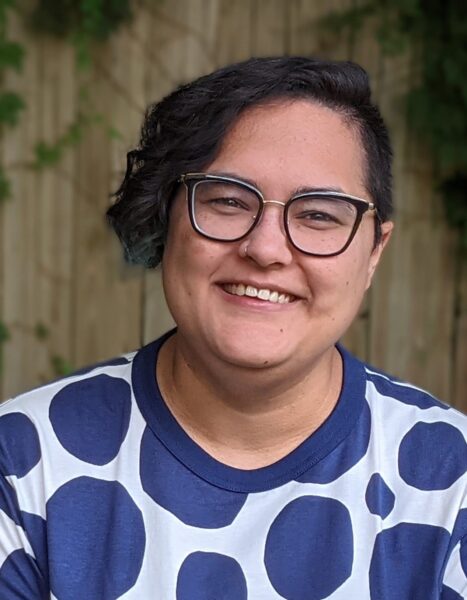Your story clearly benefits from the construction of its narrative voice, with a sense of progression revealed primarily through the evolving language. This is arguably most impactful in the contrast between the beginning, when the dog is described simply as looking like a few disparate things, and the ending, when the narrator’s appearance becomes interwoven with a deep history comprising both treasured memories of her family and past racist abuse. Do you find that flash fiction inherently demands more from its writing style than do longer stories?
Flash fiction rewards experimentation. I am much more experimental in flash than I am in longer work. The form demands from its authors new ways of conceiving storytelling because it’s so condensed, but you still owe your readers a complete narrative arc. The form demands tightness even while reaching for vastness: each word in its perfect place while also leaving pauses for pace, for implication, for readers’ imaginations to bloom. Ideally, longer work would do this as well, but with extra elbowroom comes the temptation to sprawl. In flash, there is no such luxury.
There is such a high level of detail throughout your story, much of it concerned with society’s emphasis on branding and labels. In the first half, this takes the form of popular product names and pop-culture references, but it takes a turn in the second half as it gives way first to the nationalities and ethnicities from which we derive so much of our respective identities and finally to the common slurs used to denigrate such categories. What do you see as the relationship between these details? When writing a story, do you tend to chart out such modulation, or do you find it naturally emerges from having a firm handle on a story’s thematic intent?
Part of what DNA kits sell is yourself. “Tell me about me: my favorite subject.” The idea is to commodify people’s questions about themselves the same way you would a product. But you can’t sell someone a culture. You can’t sell someone their upbringing. Likewise, a DNA test cannot restore what history has erased.
I’m very much a planner, which people find disappointing somehow, but I always leave room for epiphany. That often—always?—ends up giving a piece its fire. About three quarters through writing the first draft of this story, I suddenly knew what the final lines would be, and that gave me something to write toward.
Much of your story’s emotional urgency comes from its style: an interior monologue built around stream-of-consciousness prose, channeling the narrator’s frustration with not only how others see them but also how they view themselves. What role did you want the story’s narrative voice to play in its thematic exploration? In what ways does language and structure tend to become a significant part of the plot?
I tend toward “voicey” stories in which the way a narrator tells a story is inextricable from the story itself. In this piece, there are a few shifts in the narrative drive that serve to increase tension but also to provide insight into the narrator’s state of mind. Without that claustrophobically close glimpse into the narrator’s complicated relationship to a body and identity marked with pain, joy, and a history of erasure, there is no story.
For me, a successful story achieves total integration between language, plot, theme, and structure. Otherwise, it’s just a summary.
The narrator seems suspicious of the motivation behind society’s enthusiastic embrace of genetic testing, believing it to be based on the pursuit of validating one’s ethnic identity according to specious external standards. Do you share the narrator’s concerns? How do you see this testing being used in the future?
My grandpa spent twenty-five years of his life researching our genealogy without the Internet. This was an incredibly involved process, at the end of which he compiled what he found into a book. It had not only a detailed family tree but stories, news clippings, hot gossip about people two hundred years dead. It comes as no surprise that I’m wildly interested in DNA tests, but almost as soon as they debuted, stories trickled in of the results being sold to law enforcement and other government agencies. Surprise! They were using the information to target communities of color in particular. There is nothing prohibiting this practice:
Genetic testing is an inexact science with real consequences
Sigrid Johnson Was Black. A DNA Test Said She Wasn’t.
It’s much easier to find kinship connections through DNA kits than it is to pinpoint your exact “ancestry.” Did you know different companies’ kits will give you different ethnicity results? It’s because their ethnic-marker information is actually based on their own client base and inferences thereof. Did you know that because African and Asian DNA is less represented in these client bases, those results are much more likely to be inaccurate? Did you know some dog DNA kits were coming back with results that said “Native American?” I hope I don’t have to elucidate how racist that is. There is very little to suggest the way these tests trace heritage is sound.
I’m not suggesting no one should use them. I think they’re invaluable, especially for people searching for family, but the questions of accuracy, privacy, and sale should give potential customers pause. Law enforcement is not always finding the Golden State Killer with these things. Mostly, they’re just finding your fourth cousin who did a petty theft once so they can storm his house to arrest him for an eighth of weed.
Finally, at any point did you consider a version of this story wherein the narrator ultimately takes one of these tests and has to deal with the results?
I had originally conceived it as a story in which someone who receives a surprising result boards a plane to this new country of origin, but once there, feels alienated and out of step with the culture and buys a ticket to the “old” home country. This iteration of it, however, felt like a simplistic fable spoiled by ham-fisted moralizing.



 The core workshop of SmokeLong Fitness is all in writing, so you can take part from anywhere at anytime. We are excited about creating a supportive, consistent and structured environment for flash writers to work on their craft in a community. We are thrilled and proud to say that our workshop participants have won, placed, or been listed in every major flash competition. Community works.
The core workshop of SmokeLong Fitness is all in writing, so you can take part from anywhere at anytime. We are excited about creating a supportive, consistent and structured environment for flash writers to work on their craft in a community. We are thrilled and proud to say that our workshop participants have won, placed, or been listed in every major flash competition. Community works.